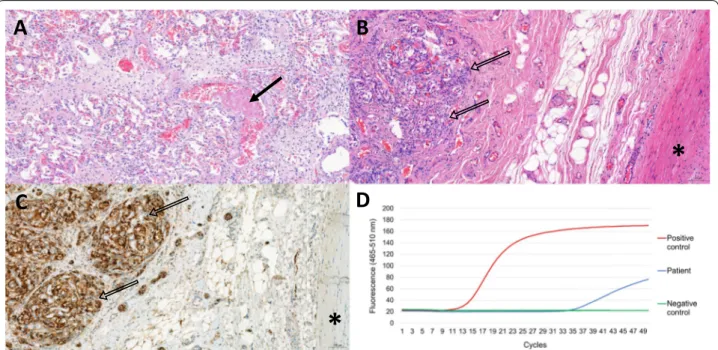Intensive Care Med
https://doi.org/10.1007/s00134-021-06351-z
IMAGING IN INTENSIVE CARE MEDICINE
SARS-CoV-2 in carotid body
Bernard Lambermont
1*, Eric Davenne
2, François Maclot
3and Philippe Delvenne
2© 2021 Springer-Verlag GmbH Germany, part of Springer Nature
A 42-year-old man was admitted to the intensive care unit in October 2020 for coronavirus disease-19 (COVID-19)-related acute respiratory distress syndrome requiring mechanical ventilation. He presented with multi-organ failure and died 41 days later. Comorbidities included a sleeve gastrectomy in 2016 and cholecystec-tomy in April 2020.
Autopsy revealed diffuse alveolar damage (Fig. 1A) and presence of severe acute respiratory syndrome-corona-virus 2 (SARS-CoV-2) in the carotid body (Fig. 1B, C). Detection of SARS-CoV-2 in the carotid body was per-formed by real-time reverse transcription polymerase chain reaction (Fig. 1D).
The carotid body plays a role in peripheral arterial chemoreception, in metabolic and immune sensing, and could also be a route of nervous system invasion by CoV-2. Involvement of the carotid body by SARS-CoV-2 may explain silent hypoxemia and thus could also contribute to increased morbidity and mortality in COVID-19 patients.
Author details
1 Department of Intensive Care, University Hospital of Liege, Liège, Belgium. 2 Department of Pathology, University Hospital of Liege, Liège, Belgium. 3 Department of Microbiology, University Hospital of Liege, Liège, Belgium.
Funding
None.
Compliance with ethical standards Conflicts of interest
The authors declare that they have no conflict of interest.
Publisher’s Note
Springer Nature remains neutral with regard to jurisdictional claims in pub-lished maps and institutional affiliations.
Received: 29 December 2020 Accepted: 8 January 2021
*Correspondence: b.lambermont@chuliege.be
1 Department of Intensive Care, University Hospital of Liege, Liège, Belgium
Fig. 1 A Post-mortem tissue specimen showing a diffuse alveolar damage and a partially occluded microvascular structure in the lung (arrow) (hematoxylin eosin; × 100); B lobules of the left carotid body (open arrows) separated by thin connective tissue septa and located in close proximity of a muscular artery wall structure (asterisk) (hematoxylin eosin; × 100); C immunohistology with an antibody against S-100 protein demonstrating many immunostained sustentacular and Schwann cells surrounding neuroendocrine chief cells within the lobules (open arrows) (immunoperoxydase; × 100); D real-time reverse transcription polymerase chain reaction using the Taqman® technology on LC480 thermocycler (Roche, Switzerland) and showing detection curves (blue curve for patient tissue; red and green curves for positive and negative controls, respec-tively) of severe acute respiratory syndrome-coronavirus 2 N1/N2 gene transcripts (cycle threshold: 36) after glomus tissue microdissection and RNA extraction from paraffin-embedded sections (tested in triplicate)
